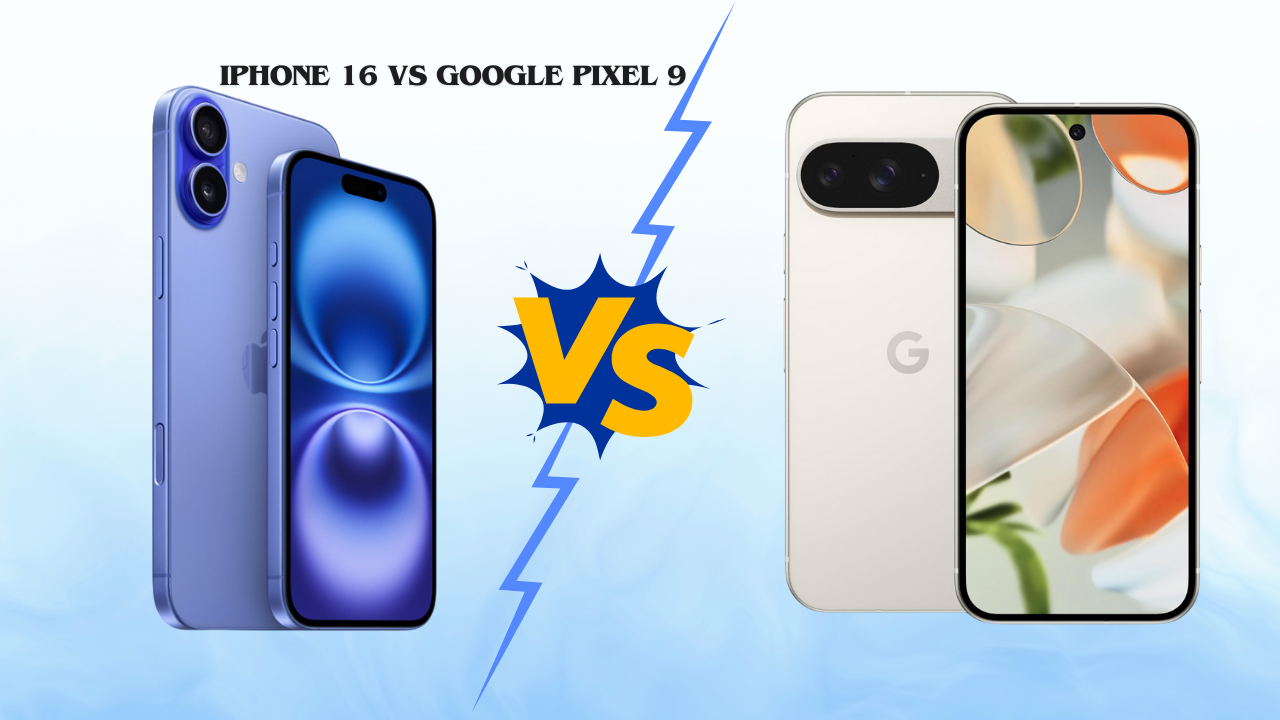In the ever-evolving world of smartphones, the battle between tech giants Apple and Google intensifies with each new release. This year, the much-anticipated iPhone 16 vs Google Pixel 9 are set to clash, each vying for the top spot in the hearts and pockets of consumers. With cutting-edge features, powerful processors, and stunning camera capabilities, both phones promise to deliver an exceptional user experience. In this comprehensive comparison, we’ll delve into the key differences between the iPhone 16 and the Google Pixel 9, helping you make an informed decision about which device best suits your needs and preferences.
A. Brief Introduction to iPhone 16
The iPhone 16, Apple’s latest flagship smartphone, is expected to continue the legacy of innovation and premium design. While official details are yet to be released, rumors suggest significant advancements in camera technology, processing power, and battery life.
- Key Features and Specifications (Projected):
- A17 Bionic chip for unparalleled performance.
- Enhanced camera system with improved low-light photography and videography.
- Longer battery life for extended usage.
- Upgraded display with ProMotion technology for smoother visuals.
- Design and Build Quality:
- The iPhone 16 is expected to retain Apple’s signature sleek design with a focus on premium materials and meticulous craftsmanship.
- Expect a durable build with water and dust resistance.
- Unique Selling Points:
- Seamless integration with the Apple ecosystem.
- iOS 17 with its focus on user experience and privacy.
- Powerful A17 Bionic chip for superior performance.
B. Brief Introduction to Google Pixel 9
Google’s Pixel 9 is anticipated to be a powerhouse in computational photography and AI-driven features. The Pixel line is known for its exceptional camera capabilities and pure Android experience.
- Key Features and Specifications (Projected):
- Next-generation Google Tensor chip for improved AI processing.
- Cutting-edge camera system with advancements in computational photography.
- Stock Android experience with timely updates.
- Enhanced battery life and faster charging.
- Design and Build Quality:
- The Pixel 9 is likely to feature a refined design with a focus on sustainability and recycled materials.
- Expect a premium build with water and dust resistance.
- Unique Selling Points:
- Pure Android experience with timely updates.
- Industry-leading camera capabilities powered by Google’s AI technology.
- Google’s software optimizations for smooth performance.
C. Target Audience and Market Position
- Intended users for iPhone 16:
- Brand-loyal Apple users seeking the latest and greatest technology.
- Users who value a seamless ecosystem experience with other Apple devices.
- Those willing to pay a premium for a high-quality smartphone.
- Intended users for Google Pixel 9:
- Android enthusiasts who prioritize camera quality and a pure Android experience.
- Tech-savvy users interested in the latest advancements in AI and computational photography.
- Users seeking a premium Android smartphone with timely software updates.
- Comparison of market strategies:
- Apple focuses on building a premium brand image with a loyal customer base. They emphasize seamless integration within their ecosystem and a user-friendly experience.
- Google leverages its expertise in AI and software to deliver innovative features, particularly in the camera department. They appeal to Android enthusiasts and users seeking a cutting-edge experience.
Design and Display
A. Physical Appearance and Build Materials
- iPhone 16 design elements:
- It’s likely to retain the iconic flat-edge design introduced with the iPhone 12 series.
- Expect refinements to the camera module and possibly a smaller notch or even a punch-hole display.
- Premium materials like surgical-grade stainless steel and ceramic are likely to be used for the Pro models.
- Google Pixel 9 design elements:
- The Pixel 9 may see a more significant design overhaul, with rumors of a refreshed camera bar and a slightly curved display.
- Google’s commitment to sustainability may lead to the use of recycled materials in its construction.
- A premium build with a combination of metal and glass is expected.
- Comparison of build materials and durability:
- Both phones are likely to feature robust build quality with water and dust resistance.
- The iPhone 16’s potential use of stainless steel and ceramic could offer slightly better scratch resistance compared to the Pixel 9’s likely metal and glass construction.
B. Display Technology and Performance
- iPhone 16 display specifications:
- Expected to feature OLED displays with ProMotion technology offering refresh rates up to 120Hz for smoother scrolling and animations.
- Improved peak brightness and HDR support are also anticipated.
- Google Pixel 9 display specifications:
- Likely to sport a high-quality OLED display with a smooth 120Hz refresh rate.
- Google may focus on color accuracy and HDR performance.
- Usability comparisons in different environments:
- Both displays should offer excellent visibility in various lighting conditions, including bright sunlight.
- The iPhone 16’s ProMotion technology might provide a slightly more fluid and responsive user experience.
C. Ergonomics and User Comfort
- Dimensions and weight of iPhone 16:
- Exact dimensions and weight are unknown, but expect similar sizes to the iPhone 15 series, with Pro models being slightly heavier due to premium materials.
- Dimensions and weight of Google Pixel 9:
- Dimensions and weight are yet to be confirmed, but expect a comfortable size for one-handed use with a slightly lighter build compared to the iPhone 16 Pro models.
- User experience in day-to-day handling:
- Both phones should offer a comfortable grip and feel premium in hand.
- The Pixel 9’s potentially lighter weight and curved display might offer a slight edge in ergonomics for some users.
Camera Capabilities
The camera is a crucial deciding factor for many smartphone buyers, and both the iPhone 16 and Google Pixel 9 are expected to push the boundaries of mobile photography.
A. Camera Specifications and Features
- iPhone 16 camera specifications and features:
- The iPhone 16 Pro models are rumored to have a significant camera upgrade, possibly featuring a larger main sensor and improved telephoto lens.
- Expect advancements in computational photography, including enhanced low-light performance and improved dynamic range.
- New video recording features like higher frame rates and improved stabilization are also anticipated.
- Google Pixel 9 camera specifications and features:
- The Pixel 9 is likely to continue Google’s tradition of exceptional camera performance, leveraging its advanced AI algorithms and computational photography.
- Improvements in zoom capabilities and low-light photography are expected.
- New video features such as cinematic mode and improved HDR video recording are possibilities.
- Innovative technologies employed:
- Both phones are likely to incorporate cutting-edge technologies like sensor-shift stabilization, larger pixels for better light capture, and AI-powered image processing.
- The Pixel 9 may introduce new AI-based features for creative photo and video editing.
B. Image Quality Comparison
- Analysis of photo quality in various lighting conditions for iPhone 16:
- The iPhone 16 is expected to excel in various lighting conditions, producing sharp, vibrant images with accurate colors.
- Low-light photography is likely to be significantly improved, thanks to larger sensors and advanced computational photography.
- Analysis of photo quality in various lighting conditions for Google Pixel 9:
- The Pixel 9 is expected to be a champion in computational photography, delivering stunning images with exceptional detail and dynamic range.
- Its AI-powered algorithms may offer unique features like Magic Eraser and improved portrait mode.
- User preferences for image processing and color accuracy:
- Image processing and color accuracy are subjective preferences. Some users may prefer the natural look of iPhone photos, while others may appreciate the Pixel’s AI-enhanced images.
C. Video Recording Performance
- iPhone 16 video recording features and quality:
- The iPhone 16 is likely to offer improvements in video recording, including support for higher frame rates and resolutions.
- Enhanced stabilization and improved low-light video performance are expected.
- Google Pixel 9 video recording features and quality:
- The Pixel 9 is likely to excel in video recording, thanks to its advanced AI capabilities and computational photography.
- Features like cinematic mode and improved HDR video recording are possibilities.
- User feedback and reviews on video capabilities:
- User feedback and reviews will play a crucial role in determining the actual video recording performance of both phones.
- It’s advisable to wait for real-world reviews and comparisons before making a final judgment.
Performance and Software
A. Processing Power and Specifications
- Processor specifications for iPhone 16:
- The iPhone 16 is expected to be powered by Apple’s A17 Bionic chip, built on a cutting-edge 3nm process.
- This chip is anticipated to offer significant performance improvements over its predecessor, with faster CPU and GPU speeds, as well as enhanced energy efficiency.
- Processor specifications for Google Pixel 9:
- The Pixel 9 is rumored to feature the next-generation Google Tensor G4 chip.
- While specific details are scarce, it’s likely to focus on AI processing and machine learning capabilities, powering advanced camera features and software optimizations.
- Real-life performance benchmarks:
- Until official benchmarks are available, it’s challenging to predict the exact performance differences.
- However, based on historical trends, the A17 Bionic is likely to outperform the Tensor G4 in raw processing power and graphics performance.
- The Tensor G4 might excel in AI-related tasks and machine learning capabilities.
B. Operating System and User Interface
- Overview of iOS features in iPhone 16:
- The iPhone 16 will run on iOS 17, which is expected to bring new features and enhancements to the user experience.
- Expect refinements to existing features, improvements in privacy and security, and potentially new AI-driven functionalities.
- Overview of Android features in Google Pixel 9:
- The Pixel 9 will feature a stock Android experience, likely running Android 14 or a newer version.
- Stock Android offers a clean and bloatware-free interface with timely updates and access to the latest Android features.
- User experience in navigating each interface:
- iOS is known for its intuitive and user-friendly interface, with a focus on simplicity and ease of use.
- Stock Android offers a customizable experience with more flexibility for power users.
C. Software Updates and Longevity
- Update frequency and support from Apple for iPhone 16:
- Apple has a strong track record of providing software updates for its devices for several years.
- The iPhone 16 can be expected to receive major iOS updates for at least 4-5 years, ensuring long-term software support and access to new features.
- Update frequency and support from Google for Pixel 9:
- Google typically provides 3 years of major Android updates and 5 years of security updates for its Pixel devices.
- The Pixel 9 will benefit from timely updates and a longer software support cycle compared to many other Android smartphones.
- Long-term value and operating system management:
- Both phones are expected to offer good long-term value due to their extended software support.
- iOS’s streamlined updates and optimization for Apple hardware tend to provide a consistent experience over time.
- Android’s open nature allows for more customization but can lead to fragmentation and varying update experiences depending on the manufacturer.
Battery Life and Connectivity
A. Battery Specifications and Life Expectancy
- Battery capacity and performance metrics for iPhone 16:
- The iPhone 16 is expected to have a slightly larger battery than its predecessor, thanks to advancements in battery technology and the A17 Bionic chip’s improved energy efficiency.
- Apple typically doesn’t disclose battery capacities but focuses on “all-day battery life.”
- Expect optimizations in iOS 17 to further enhance battery performance.
- Battery capacity and performance metrics for Google Pixel 9:
- The Pixel 9 is rumored to have a larger battery than the Pixel 8, addressing one of the previous generation’s pain points.
- Google’s software optimizations and AI-powered battery management should further improve real-world usage time.
- Real-world usage scenarios and optimizations:
- Both phones should comfortably last a full day with moderate to heavy usage.
- Actual battery life will vary depending on factors like screen-on time, app usage, and network connectivity.
- Both iOS 17 and Android 14 are expected to offer battery-saving features and optimizations to extend usage time further.
B. Charging Methods and Speed
- Wired and wireless charging options for iPhone 16:
- The iPhone 16 is expected to continue supporting Lightning connector for wired charging and MagSafe for wireless charging.
- Rumors suggest a possible increase in wired charging speeds.
- Wired and wireless charging options for Google Pixel 9:
- The Pixel 9 is likely to feature USB-C for wired charging and support for Qi wireless charging.
- Expect faster wired and wireless charging speeds compared to the Pixel 8.
- Speed comparison and user convenience:
- Both phones are anticipated to offer fast charging options, allowing users to quickly top up their battery when needed.
- The exact charging speeds and convenience will depend on the specific chargers and technologies used.
C. Connectivity Features and Options
- 5G capabilities and other network options in iPhone 16:
- The iPhone 16 will undoubtedly support 5G networks, offering faster download and upload speeds in areas with 5G coverage.
- It will also support Wi-Fi 6E for improved Wi-Fi performance and Bluetooth 5.3 for faster and more reliable connections with accessories.
- 5G capabilities and other network options in Google Pixel 9:
- The Pixel 9 will also feature 5G connectivity for fast data speeds.
- Expect support for Wi-Fi 6E and the latest Bluetooth standard for seamless connectivity.
- Additional connectivity features (Bluetooth, Wi-Fi, etc.)
- Both phones will likely include NFC for contactless payments and UWB (Ultra-Wideband) for precise location tracking and device interactions.
Comparison Chart:
| Feature | iPhone 16 | Google Pixel 9 |
|---|---|---|
| Display | 6.1-inch Super Retina XDR display | 6.3-inch OLED Actua display |
| Processor | A16 Bionic chip | Tensor G3 |
| Camera | Dual 12MP rear cameras, 12MP front camera | Dual 50MP rear cameras, 10.8MP front camera |
| Battery | All-day battery life | Adaptive battery for up to 72 hours |
| Software | iOS 17 | Android 14 |
| Special Features | Face ID, MagSafe, Cinematic mode | Magic Eraser, Live Translate, Call Screen |
| Price | Starts at $799 | Starts at $499 |
Which one is better?
It depends on your priorities:
- If you prefer iOS and its ecosystem, the iPhone 16 is likely the better choice for you. It offers a powerful processor, a great camera system, and seamless integration with other Apple devices.
- If you want a more affordable phone with excellent camera capabilities and unique AI features, the Pixel 9 might be the better option. It offers a clean Android experience, impressive computational photography, and innovative features like Magic Eraser.
Other factors to consider:
- Performance: The iPhone 16’s A16 Bionic chip is likely to outperform the Pixel 9’s Tensor G3 in raw processing power.
- Camera: Both phones have excellent camera systems, but the Pixel 9’s AI-powered features like Magic Eraser give it an edge in certain situations.
- Battery life: The Pixel 9’s adaptive battery might offer longer battery life than the iPhone 16, but real-world usage will vary.
- Software updates: Google typically provides longer software support for Pixel phones compared to Apple’s iPhones.
Ultimately, the best phone for you depends on your individual needs and preferences. I recommend trying both phones in person, if possible, to see which one feels right for you.
Conclusion:
Both the iphone 16 vs google pixel 9 promise to be exceptional smartphones, each with its unique strengths and appeal. The iPhone 16, with its powerful A17 Bionic chip, seamless ecosystem integration, and refined design, is a compelling choice for Apple enthusiasts and those seeking a premium, user-friendly experience. On the other hand, the Google Pixel 9, with its cutting-edge camera capabilities, pure Android experience, and AI-driven features, will attract Android fans and tech-savvy users who value innovation and performance. Ultimately, the best choice depends on your individual preferences, priorities, and ecosystem loyalty. Consider factors like camera performance, software experience, battery life, and overall value before making your decision. Regardless of your choice, both the iPhone 16 and Pixel 9 are poised to deliver a top-tier smartphone experience.
FAQ’s
Which is better, iPhone or Google Pixel?
It depends on your preferences. iPhones offer a seamless ecosystem and strong performance, while Pixels excel in computational photography and AI features
What is the zoom on iPhone 16 Pro Max?
The iPhone 16 Pro Max has a 5x optical zoom and can digitally zoom up to 25x.
What is new about the iPhone 16 Pro?
New features on the iPhone 16 Pro include an upgraded A16 Bionic chip, improved cameras, and potentially a new titanium frame design.
Are Pixel photos better than iPhone?
Both phones have exceptional cameras. Pixels are generally considered to have an edge in low-light photography and AI-powered features, while iPhones tend to offer more natural colors and better video quality.


